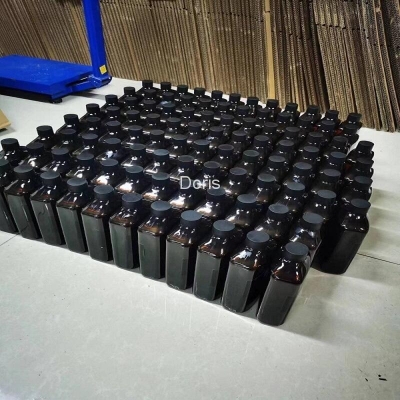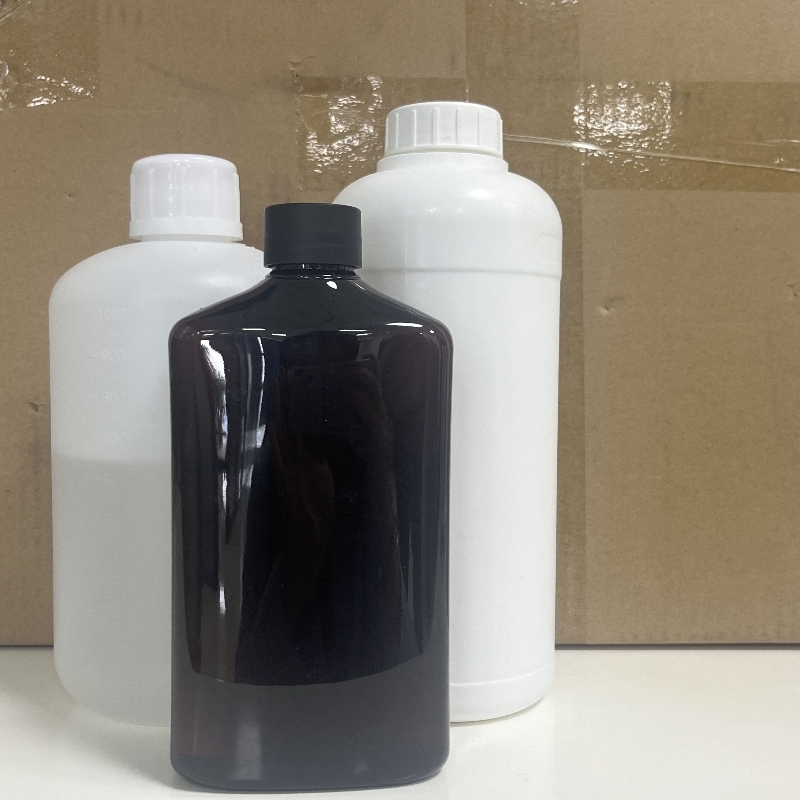-
Categories
-
Pharmaceutical Intermediates
-
Active Pharmaceutical Ingredients
-
Food Additives
- Industrial Coatings
- Agrochemicals
- Dyes and Pigments
- Surfactant
- Flavors and Fragrances
- Chemical Reagents
- Catalyst and Auxiliary
- Natural Products
- Inorganic Chemistry
-
Organic Chemistry
-
Biochemical Engineering
- Analytical Chemistry
- Cosmetic Ingredient
-
Pharmaceutical Intermediates
Promotion
ECHEMI Mall
Wholesale
Weekly Price
Exhibition
News
-
Trade Service
Recently, the domestic biopharmaceutical company Baiji Shenzhou announced that it will seek to list on the A-share board, which is expected to be completed in the first half of 2021.
previously, Baiji Shenzhou was listed in the U.S. and Hong Kong stocks in 2016 and 2018, respectively, after the success of the listing of the board, Baiji Shenzhou may become the first pharmaceutical company listed in three places.
By the end of the draft, the value of the Hong Kong stock market in Baiji Shenzhou had exceeded HK$200 billion, and the value of the US stock market had reached US$25,761 million, and it may be hard to imagine that Baiji Shenzhou, a biopharmaceutical company with a cumulative loss of more than 19 billion yuan, had become a pharmaceutical company with a market capitalisation of more than 19 billion yuan.
, but unfortunately, there are not many companies in the biomedical field that are recognized by the capital markets, like Baiji Shenzhou.
Biotech's model doesn't quite work at home.
just before, to Hong Kong stocks listed in the first sound pharmaceutical industry, drug Ming Juno these two only high holdings of biopharmaceutical enterprises broke down.
listed in Hong Kong shares of Goli Pharmaceuticals, pioneering pharmaceutical industry, Yunding Xinyao and other biopharmaceutical companies have also continued to fall, there are a number of biopharmaceutical enterprises have fallen sharply below the issue price.
some people think that one of the advantages of the HKEx is that it is dominated by institutional investors and that the value of the company is found to be more accurate than that of the Mainland.
and biopharmaceuticals in Hong Kong stocks underperformed, with some questioning the bursting tide of biopharmaceuticals and the bursting of the biopharmaceutical bubble.
On the other side of the Hong Kong-listed biopharmaceutical companies also have excellent results, and Synong Pharma, Pharmaceuticals Juno listed in the same period Rongchang Bio, also by Gao Hao as one of the cornerstone investors, the first day of the Hong Kong stock market closing price of HK$69.8, up 33.97 percent from the issue price, Rongchang Bio market value of more than 30 billion yuan.
the biopharmaceutical industry is overheating, it is difficult to determine, and there is a certain bubble, for the biopharmaceutical industry, is not necessarily a bad thing.
, the short-term stock price volatility of biopharmaceuticals now gives us an opportunity to re-examine the biopharmaceutical industry.
in the multi-flowered biopharmaceutical industry, what kind of enterprises have the value of long-term investment, biopharmaceutical enterprises should be composed of what dimensions of investment value? On one side is the Hong Kong stock break tide, on the other side is the biomedical fever in fact, this is not the first time that the Hong Kong stock staged a bio-pharmaceutical break tide.
2018, hkEx overhauled to allow unprofitable biotech companies to list.
this policy has attracted a large number of biopharmaceutical companies ready to go to the NASDAQ listing in the United States into the arms of the Stock Exchange.
but the first wave of crab-eating enterprises did not get a dividend, the first listed song ceremony, the follow-up Baiji Shenzhou have broken.
in the domestic biopharmaceutical industry, which is in the midst of a period of rapid development, it is difficult to define stock price fluctuations directly as a lack of company value.
's 2018 boom coincides with a downturn in Hong Kong stocks, which have fallen 24 per cent from their peak.
, Baiji Shenzhou, Ping An Health and other medical and health units without exception broke, the medical industry outside the dream world, the United States group reviews are not immune.
, hong Kong stocks have been allowing unprofitable biopharmaceutical companies to list for two years, and more than 20 unprofitable biotech companies have listed in Hong Kong.
may provide a glimpse into the secondary market's preferences for biopharmaceutical companies from their share price changes.
data, there were 36 biotechnology companies in Hong Kong in November 2018-2020 with a total market capitalisation of less than 800 billion yuan.
20 of them were unprofitable biotech companies, and overall, unprofitable biotech companies performed flatly in Hong Kong.
, Jia and Bio, Yongtai Bio, Pioneer Pharmaceuticals, Keystone Pharmaceuticals, Hualing Pharmaceuticals and other companies have fallen below the issue price.
, of course, short-term fluctuations in share prices are also influenced by many external factors, such as market conditions, and cannot be directly equated with company value.
But the summary shows that the underperforming enterprises in Hong Kong stocks can be divided into two main categories, one is concentrated in PD-1/L1, cell therapy such as hot tracks, the other is at this stage mainly the use of licensing (license-in) model.
this wave of biomedical breakthroughs is also partly related to the market's disappointment and doubts about the crowding of biopharmaceutical tracks and the value of the model.
in the secondary market, the performance of biopharmaceutical stocks did not affect the investment heat of biopharmaceuticals in the secondary market.
biopharmaceutical industry, regardless of the amount or quantity of investment and financing leading the entire medical financing market, biopharmaceutical industry valuations continue to double.
according to the Arterial Orange Database, from January to November 11, 2020, more than 200 financings were made in the biopharmaceutical sector, with many enterprises financing amounting to 1 billion yuan.
the capital side of an industry that continues to pour in brings essential support to this high-risk, high-investment industry, helping scientists make the leap from 0 to 1.
But it also brings hidden worries, in Hong Kong stocks allow unprofitable biotechnology listing, science and technology board open registration system and other background, part of the short-term capital will be out of profit-making nature, in order to achieve short-term arbitrage, overdraft biopharmaceutical industry development, and finally lead to weak innovation, destroy the domestic fragile innovation drug innovation ecology.
but the biopharmaceutical industry is different from the Internet industry, capital assistance can accelerate the process of industry.
biopharmaceutical industry is hard technology, the need for long-term research and development, there is a long-term sitting cold bench adhere to.
-term capital heat can't stay with an industry with a research and development cycle that lasts for decades.
as a word says, afraid that he will not come, and afraid of him messing around.
on the one hand, bio-innovative pharmaceutical companies in Hong Kong stocks flat performance, on the other hand is the first-tier market hot biopharmaceutical investment, the two, the bio-pharmaceutical industry bubble will burst? PD-1/L1 market and the pattern of license-in are authentic? How crowded tracks are allowing a growing number of biopharmaceutical companies, PD-1/L1, to dream of a hundred billion-dollar market before they go public and keep reducing prices is often seen as a manifestation of the bursting of the biopharmaceutical bubble.
PD-1/PD-L1 immunotherapy is a new anti-cancer treatment that has emerged in recent years and is a new hope for many cancer patients.
June 2018, since the first PD-1 single-anti-O drug was listed in China, major pharmaceutical companies and national review bodies have made efforts, so far a total of eight PD-1/PD-L1 single-resistance listed in China.
, some people have questioned whether the PD-1/PD-L1 pile-up, innovative drugs into homogenization competition, will cause overcapacity? Is it a continuation of weak innovation and excessive repetition? At least from a patient access point of view, PD-1/PD-L1 piles so that the "drug god" no longer high prices, which is not a bad thing.
according to the current O-drug, K drug published domestic prices, although the lowest in the world, but still need to pay 30-60 million / year, for most Chinese families, this price is not a small burden.
2019, Junshi Bio officially announced its PD-1 single-resistance pricing, shocked the industry, the annual treatment cost of only 1872 million yuan, less than 1/3 of imported drugs.
, Hengrui Pharmaceuticals PD-1 Erica, launched the "annual drug cost of 39,600 yuan" in the fourth quarter of the promotion.
-term promotion of Hengrui Pharmaceuticals has made the price war of PD-1 into the million yuan level.
with the successive listing of immunologic drugs, the price competition between the drugs white heats up, in a number of local enterprises to catch up, foreign pharmaceutical companies are also difficult to say easy.
the biggest benefit is, of course, that patients and their families will gradually be able to use these new drugs at lower prices.
PD-1/L1 pile is not a bad thing for patients.
But will low-cost innovative pharmaceutical products devour the entire innovative pharmaceutical industry, PD-1/L1 is already a Red Sea, and then enter the PD-1/L1 market enterprises can only be reduced to cannon fodder? First look at the existing market ranking, throughout the PD-1 track, Mercadon's K drug by virtue of clinical results and the number of adaptive diseases, occupy the high-end market;
in the first half of 2020, Thyme Bio's Daboshu received 921 million yuan in sales, Xinda Bio PD-1 sales revenue exceeded 600 million yuan in the third quarter, and total sales in the first three quarters of 1.521 billion yuan.
Yuanshi Bio's Tuyi and Bai Zean of Baiji Shenzhou sold 426 million yuan and 499.43 million U.S. dollars (about 343 million yuan) respectively in the first half of the year.
in an already competitive market like PD-1/L1.
how to get a piece of the action, there are still companies trying to create differentiated routes by developing unique clinical adaptations and drug combinations.
, for example, Jia and Bio, whose preferred strategy for PD-1 single-resistant GB226 (geptanolimab) is to focus on differentiated adaptations in the Chinese market.
exocyte t-cell lymphoma (PTCL) is a non-Hodgkin's lymphoma (NHL) type, which is rare in Europe and the United States, accounting for only about 6% to 10% of all NHL cases, and the FDA has not yet approved PD-1 monoantigens for PTCL treatment, but the lymphoma subtype is relatively common in Asian countries, accounting for about 21.4% of all NHL cases.
addition, players in the PD-1/PD-L1 field are seeking to further differentiate from the way drugs are treated together.
for the same adaptive disorder, companies can extend the life cycle of PD-1 products through different combined treatment methods.
, Baiji Shenzhou in the domestic PD-1 sales, not ahead.
, the PD-1 Terriju single anti-injection solution in Baiji Shenzhou is being developed as a single drug and combination therapy for a range of adaptations to the treatment of solid and blood tumors.
15 registered clinical trials are currently conducted in China and around the world, including 11 Phase 3 clinical trials and four critical Phase 2 clinical trials.
it is worth noting that in the sale of the golden stage of the initial public listing is of course an advantage, but strong sales capacity of pharmaceutical companies can also be later.
This also has great inspiration to domestic pharmaceutical companies: in the domestic not to research and development of the company, as long as the stage of innovative drug research and development is not too backward, to ensure that their similar products in 2 to 8 years timely listing, it is likely to be launched later, in the second half of the sales golden period to catch up.
Hengrui Pharmaceuticals in PD-1/L1 sales later came to the fore precisely because of its strong sales capacity.
At different stages of track development, entrepreneurs with a great view of the pattern should think about the development of the industry to a certain stage, when the market competition stabilizes, which resources can not be expanded, which resources are exclusive or scarce, and then think about how to overcome these obstacles, and strive for greater space for development.
How to seize the "biopharmaceutical fever" to enhance the whole industry to review the development of innovative drugs in China, as early as 2000, China has a rapid follow-up type of enterprises, Beida Pharmaceuticals, micro-core organisms were born in it.
2010, PD-1 single target belt fire the entire industry, and achieved the success of Baiji Shenzhou, Xinda, Junshi and other second wave of enterprises.
China's biopharmaceutical industry, although there have been several booms, but has been in a state of catch-up.
invested in more than dozens of biopharmaceutical enterprises in China, said: "China's pharmaceutical industry is large but not strong, drug quality differences are large, not only very few innovative drugs, and generic drugs are difficult to reach the "high imitation" level."
patients' demand for high-quality generics is still a gap compared to the accessibility and affordability of current drugs.
At present, most of the innovative drugs entering clinical research in China are trace innovative drugs with known targets and pilot compounds abroad, the reasons for which, on the one hand, the accumulation of basic research on new drug creation in China is relatively weak, the basic research layout of applied basic research is insufficient, and the basic research results such as new targets, new mechanisms and methods are lacking;
" has been insufficient investment of funds and talents, lack of attention to basic research, lack of forward thinking and strategic vision, these three points seriously restrict the development of China's biopharmaceutical industry.
to improve, the above-mentioned investors believe that the biopharmaceutical industry and the same hot chip industry, the biopharmaceutical industry needs to strengthen cooperation, blooming.
through international cooperation, we will guide pharmaceutical enterprises to actively respond to and participate in international competition, learn foreign advanced technology and management experience, and continuously improve the ability and level of domestic enterprises to create new drugs.
one of the main forms of international cooperation is the licensing of the introduction of license-in, " he added.
The premise of this model, however, is that the introducer must have the clinical propulsion ability and top clinical talent to match the world's top pharmaceutical companies in order to apply the first-of-its-kind or best-in-class drugs to Chinese patients.
" was once a good business model for domestic biopharmaceutical companies, but now the price of license-in has been raised and license-in has become a slightly more expensive model.
License-in and Follow Innovation are not the sexiest stories, but they are a "shortcut" to innovation in China's biopharmaceutical industry.
to replicate the growth model of biotech in the United States, but there is an opportunity to repeat the fast-growing growth path of Japanese pharmaceuticals over the past two decades.
Japanese pharmaceutical companies have mostly seized the once-in-a-lifetime opportunity of innovation breakthroughs in the 1980s, narrowing the gap with the world's top drug companies by relying on follow-on innovation as a strategy.
Japanese pharmaceutical companies started out as generics in the 1970s, and since the Japanese drugmaker's own research and development base was still weak and difficult to achieve a First-in-class breakthrough, most of them adopted a follow-on innovation strategy.
Japanese pharmaceutical companies can develop at a high speed, corner oversized, can not be separated from the global 70's began the outbreak of innovative drug research and development, Japan enjoy Europe and the United States







